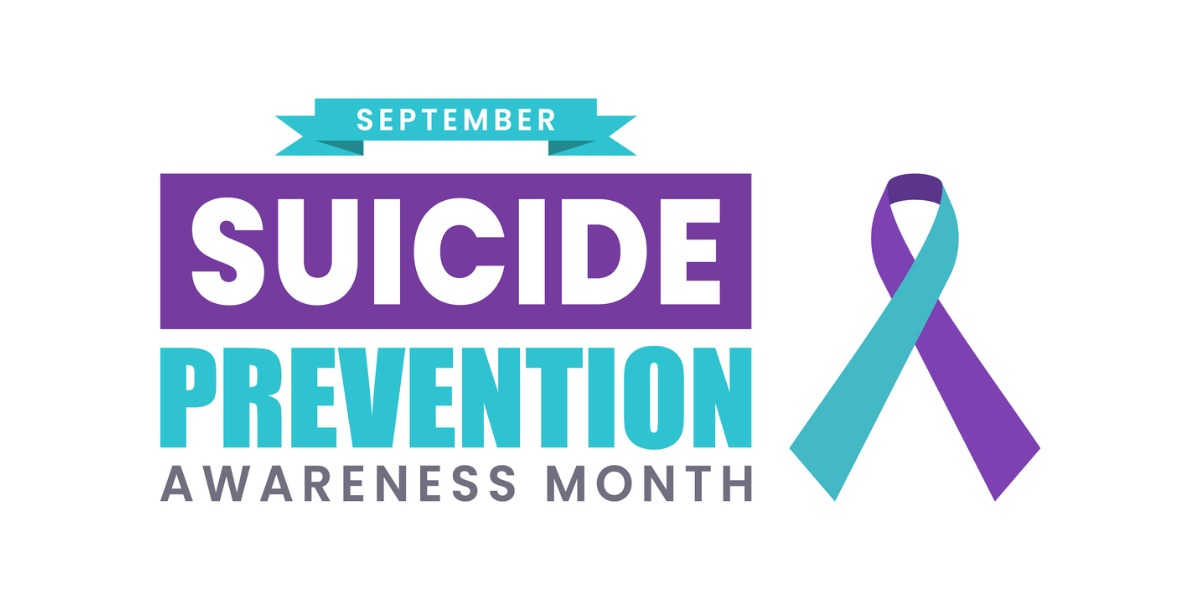Summary: You can help during Suicide Prevention Awareness Month by learning and sharing information to promote the weekly themes established by the advocates and organizers. People with mental health disorders such as depression and schizophrenia are at increased suicide risk.
Key Points:
- Suicide is preventable.
- People with lived experience with suicidality offer invaluable insight to the suicide prevention advocacy movement.
- Enhancing access and creating practical pathways to care encourages people to seek professional support.
- Professional support can reduce suicidality and save lives.
What is Suicide Prevention Awareness Month?
Every year during the month of September, a group of government and private non-profit groups work together to host Suicide Prevention Awareness Month. Advocates from the Substance Abuse and Mental Health Services Administration (SAMHSA), the National Institutes of Health (NIH), the National Alliance on Mental Illness (NAMI), and others defined the following theme for Suicide Prevention Awareness Month:
“Together in Strength, Dignity, Hope, and Purpose.”
They further clarify the unifying meaning of this theme:
“When we stand together in strength, dignity, hope, and purpose, we can make a difference. We can help save lives.”
Specific awareness-raising objectives include:
- Recognizing the warning signs for suicide
- Encouraging open conversations about mental health
- Normalizing seeking help for suicidality
- Connecting people to proven treatment and resources
Your voice matters, and your voice can help. No matter where you find your motivation, you can play a role and help change someone’s life for the better, and help during Suicide Prevention Awareness Month. You may:
- Experience challenges yourself
- Want to help a friend or loved one experiencing suicidality
- Want to help because of a past experience with a friend or loved one
- Simply want to help
Everyone is welcome, everyone can contribute, and everyone’s voice matters.
How Many People Need Help During Suicide Prevention Awareness Month?
Here’s why we need every willing voice to help raise awareness about suicide prevention, in the words of the organizers at SAMHSA:
“Suicide affects millions of people every year, yet too many struggle in silence.”
If you can speak for people who can’t find a way to speak for themselves, you can help them find their voice, ask for help, and change their lives for the better. When we say suicide affects millions of people, we mean the people experiencing suicidality and their friends and families.
Consider the following facts.
According to the 2024 National Survey on Drug Use and Health (2024 NSDUH), the Centers for Disease Control (CDC), and the National Institutes of Health (NIH), in the year 2023:
- 5% of adults over age 18 seriously considered suicide – that’s almost 12 million people.
- 20% of high school students seriously considered suicide – that’s almost 10 million high school kids
- 12% of adults 18-25 seriously considered suicide – that’s just over 4 million people.
Also, in 2023, close to 50,000 people died by suicide, and every one of them had family, friends, and community connections. Those are the people that need your support, your voice, and your help during suicide prevention awareness month.
Suicide Prevention Awareness Month: Weekly Themes to Promote and Share
For 2025, the organizers at SAMHSA established talking points for each week of September. In order to help during suicide prevention awareness month, you can learn the information contained in these talking points, and share them in any way you think is best: via social media, through conversation with friends or people you meet, or in other creative ways you devise yourself.
We’ll share the themes and awareness points for each week, and you decide how to best use your voice to spread this information far and wide.
First Week: Understanding Risk Factors, Promoting Treatment and Hope
The primary goals are raising awareness about risk factors for suicide encouraging people to seek evidence-based treatment and building hope for the future. To do your part to help, share these facts and ideas:
- Risk factors for suicide include, but are not limited to:
- Previous suicide attempt
- History of depression
- History of trauma
- Feelings of hopelessness
- Serious chronic illness
- Recent loss of loved one
- Recent financial hardship
Knowing the risk factors can save lives.
- If a person experiences a suicide crisis, treatment can help them heal
- Evidence-based treatment combined with compassionate support helps people build resilience and rediscover hope.
Second Week: The Importance of Community
This primary goal for this week is teaching people about the vital role community support plays in suicide prevention. Community members can:
- Promote local programs for suicide prevention
- Facilitate peer-led conversations and interactions to heal trauma a increase a sense of connection and belonging to the community.
Community connection is a protective factor that reduces suicidality.
- Use their lived experience to reduce stigma and build trust around treatment. People are more likely to open up and listen to those with a similar history and set of experiences.
Third Week: Better Care Means Better Outcomes
The primary goal for this week is teaching people that improving treatment and care for suicidality involves creating a comprehensive, holistic system that includes enhancing access, collaborating on safety plans, collaborating on ongoing care plans, and focusing on self-care for people with suicidality.
Better care means:
- Making it easier to locate and get to/access treatment.
- Creating individualized safety plans to manage subsequent instances of suicidality.
- Creating an ongoing care plan to promote long-term recovery.
- Recognizing that continuity of care is essential for long-term success.
- Teaching patients that self-care, i.e. sleep hygiene, healthy eating, daily exercise and activity, and stress management – especially with interactive hobbies, mindfulness, or spending time in natural greenspaces – can reduce risk of suicide.
Fourth Week: Connection Fosters Respect and Dignity
The primary goal for this week is amplifying the voices of people with lived experience with suicidality, meaning anyone who’s seriously thought about, planned, or attempted suicide, and/or anyone with a close friend or relative who’s seriously thought about, planned, or attempted suicide.
Amplifying the voices of people with lived experience means:
- Nothing about us without us. This phrase reminds us that decisions about how to handle suicidality must necessarily include the input of people who’ve experienced suicidality.
- Listening to and respecting the voice of people who’ve experienced suicidality increases the likelihood others will seek treatment and maintain treatment and community connections.
- Listening to people shows respect, which promotes a personal sense of value, which increases personal feelings of dignity.
- People who’ve experienced suicidality can contribute to and improve current emergency and ongoing care approaches.
- When support comes from community connections, it can have a more powerful impact than when it comes from outside the community.
A secondary goal of this fourth week is to remind people that authentic connections with real people in the community can prevent crises from happening and prevent an unfolding crisis from escalating into a tragedy. Sometimes a text, a call, conversation, or sharing a helpful resource can make all the difference. And when that text, call, or support comes from someone with direct personal experience with suicidality, it helps humanize and normalize the idea of treatment.
We’ll now offer a brief overview of the type of evidence-based treatment that’s most effective for reducing suicidality.
What Kind of Clinical Treatment Works Best for Suicide Prevention?
Evidence available in the report “Suicidal Ideation” published by the National Center for Biotechnology Information indicates that a comprehensive, multimodal approach works best for preventing suicide. The first step in treatment is accurate assessment of the nature and severity of suicidality. Mental health experts use the following assessment metrics:
- Columbia-Suicide Severity Rating Scale (C-SSRS)
- Beck Scale for Suicide Ideation (BSI)
- Suicidal Ideation Attributes Scale (SIDAS)
- Patient Health Questionnaire-9 (PHQ-9
Once a clinician reviews scores, they can arrive at an accurate diagnosis, and collaborate with the patient and their family on a treatment plan. Treatment plans may include a combination of psychotherapy, medication, brain stimulation techniques, family and peer support, and lifestyle changes.
Psychotherapeutic approaches may include, but are not limited to:
Medications for suicidality may include:
- Antidepressants
- IV ketamine, for suicidal ideation, is endorsed by the U.S. Department of Veterans Affairs (VA)
- Lithium, for people with bipolar disorder
- Clozapine, for people with schizophrenia
New and alternative treatments for suicidal ideation – with promising initial evidence for effectiveness – include brain stimulation techniques such as transcranial magnetic stimulation (TMS) and electroconvulsive therapy (ECT). These methods show benefit for some patients with suicidal ideation. However, more research is needed before these approaches become first-line treatments for suicidal behavior.
In closing, we’ll share information about the various types of peer support available for suicide prevention.
Modes of Peer Support That Help During Suicide Prevention Awareness Month
In a study sponsored by the Department of Veterans Affairs called “Peer-Based Interventions Targeting Suicide Prevention: A Scoping Review,” researchers designed a meta-analysis of studies that examined the most common types of peer support a person who experiences suicidality has access to. They identified four main types of peer support.
Peer Support for Suicidality: What Works?
- Gatekeepers are trained to assess suicide risk and refer people in need to professional support and care. Evidence shows gatekeepers improve outcomes in the military and on college campuses. Short-term training for gatekeepers can lead to effective skills for assessing risk.
- On-demand crisis support. In comparison to gatekeepers, on-demand crisis support peers receive more training and have access to more resources. On-demand crisis support peers generally receive 35-70 hours of training. Evidence shows that crisis support lines are effective in supporting patients in acute crisis as well as those with long-term mental health issues.
-
-
- Evidence shows on-demand crisis support for LGTQIA+ people can reduce suicide risk via phone lines and though in-person support in hospital emergency rooms.
-
- Acute setting crisis support. Peer support counselors in psychiatric hospitals and emergency rooms give patients access to compassionate care in institutional settings. No studies have evaluated the effectiveness of peer support in hospitals. However, evidence shows that in carceral settings (prisons/jails) peer support may reduce the length of a suicide crisis.
- Relapse/crisis prevention. This type of peer support is like a live, in-person safety plan. A person with a recent suicide crisis can participate in this type of peer support on a regular basis while they build independent coping skills. Evidence shows ongoing crisis planning and support delivered by peers is effective in increasing self-esteem, stress management, and reducing levels of suicidal ideation. In addition, evidence shows online, virtual support groups are nearly as effective as in-person mutual support groups.
While the evidence supporting the effectiveness of peer support groups is not as robust as that supporting psychotherapy and medication, the fact that people with lived experience with suicidality say peer support is essential means we include this information on our list. Peer support makes sense in every logical way: according to patients with a history of suicidality, peer support increases connection, decreases loneliness, and increases hope – all of which improve outcomes.
Resources: Finding Support for Suicidality
If you or someone you know is at risk of suicide, please get help immediately. When risk is immediate, call 911 or go to the emergency room now: do not wait. If risk of harm is serious but not immediate, call or text the 988 Suicide & Crisis Lifeline at 988. The crisis line will connect you or the person in crisis to an appropriate level of support and care.
Veterans dial 988 + 1 for 24/7 support for veterans and active-duty military.
For members of the LGBTQIA+ community, the Trevor Project offers targeted support:
- Phone (24/7/365): 1-866-488-7386
- Trevor Project Text (24/7/365): Text START to 678678
- The Trevor Project Chat: CLICK HERE
Angus Whyte has an extensive background in neuroscience, behavioral health, adolescent development, and mindfulness, including lab work in behavioral neurobiology and a decade of writing articles on mental health and mental health treatment. In addition, Angus brings twenty years of experience as a yoga teacher and experiential educator to his work for Crownview. He’s an expert at synthesizing complex concepts into accessible content that helps patients, providers, and families understand the nuances of mental health treatment, with the ultimate goal of improving outcomes and quality of life for all stakeholders.


 Myriame Nicolas, PMHNP-BC
Myriame Nicolas, PMHNP-BC Charlie Perez, PMHNP-BC
Charlie Perez, PMHNP-BC Kelvin Poon, MSN, PMHNP-BC
Kelvin Poon, MSN, PMHNP-BC


 Apneet Mann, FNP-C
Apneet Mann, FNP-C Kimberly Umansky, FNP-C
Kimberly Umansky, FNP-C Joanne Talbot Miller, M.A., LMFT
Joanne Talbot Miller, M.A., LMFT Rachael Hueftle, NP
Rachael Hueftle, NP J. Heather Fitzpatrick, LCSW
J. Heather Fitzpatrick, LCSW Agata Nowakowska
Agata Nowakowska Brianna Meacham
Brianna Meacham Maha Moses, PhD
Maha Moses, PhD Rebecca McKnight, PsyD
Rebecca McKnight, PsyD Tiffany Holm N.P.
Tiffany Holm N.P. Dede Echitey, PMHNP-BC
Dede Echitey, PMHNP-BC


